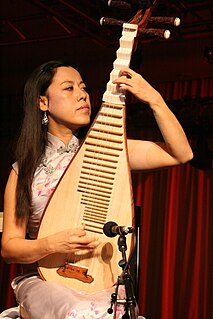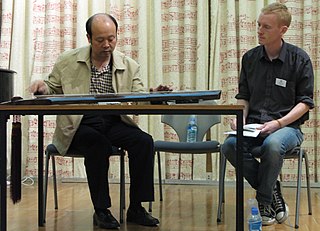
Music notation or musical notation is any system used to visually represent aurally perceived music played with instruments or sung by the human voice through the use of written, printed, or otherwise-produced symbols.
Sheet music is a handwritten or printed form of music notation that uses modern musical symbols to indicate the pitches (melodies), rhythms or chords of a song or instrumental musical piece. Like its analogs – printed books or pamphlets in English, Arabic or other languages – the medium of sheet music typically is paper, although the access to musical notation since the 1980s has included the presentation of musical notation on computer screens and the development of scorewriter computer programs that can notate a song or piece electronically, and, in some cases, "play back" the notated music using a synthesizer or virtual instruments.

Gregorian chant is the central tradition of Western plainchant, a form of monophonic, unaccompanied sacred song of the Roman Catholic Church. Gregorian chant developed mainly in western and central Europe during the 9th and 10th centuries, with later additions and redactions. Although popular legend credits Pope Gregory I with inventing Gregorian chant, scholars believe that it arose from a later Carolingian synthesis of Roman chant and Gallican chant.

Qinpu are tablature score collections for the Chinese musical instrument, the guqin.

Cheng Yu is a Chinese musician. She is internationally renowned as a performer of the pipa, a Chinese four-stringed lute, but also plays the guqin, a seven-stringed zither, and is a virtuoso, scholar and specialist of Chinese music.

Zha Fuxi, also known as Zha Yiping (查夷平) was a leading player and scholar of the guqin. Born in Jiangxi, he started learning guqin in his childhood. In 1936, he co-founded the Jinyu Qin Society (今虞琴社) which later became one of the major national musical organizations for the guqin.

Zeng Chengwei (曾成偉) is a Chinese musician of the guqin, born in the Sichuan province of China. He is a fifth-generation transmitter of the Shu school of qin music, having studied with his maternal grandfather, Yu Shaoze. Zeng is also a well-known maker of the instrument.

Guan Pinghu, was a leading player of the guqin (古琴), a Chinese 7-string bridgeless zither. Born in Suzhou, Jiangsu, Guan came from an artistic family, and started to learn the guqin from his father, Guan Nianci. After the death of his father when he was thirteen, Guan continued with his father’s friend Ye Shimeng and Zhang Xiangtao. He also studied with the leading players of three different schools; Yang Zongji (1865–1933), the leading player in Beijing, the Daoist Qin Heming, and the Buddhist monk Wucheng.
The notation of the guqin is a unique form of tablature for the Chinese musical instrument, with a history of over 1,500 years, still in use today.
The North American Guqin Association is a guqin society based in the State of California, in the United States, which serves guqin players on the West Coast of the United States. Of the three major qin societies of the West, this society was the world's largest English speaking online community for the guqin and has the most connections and scope of activities.
The London Youlan Qin Society is a London-based qin society serving guqin players in the UK. Of the three major qin societies of the West, this society was the most informal but still the most active in terms of regular events and yajis.
The history of the Guqin, an ancient Chinese musical instrument, is a long one that spans 3,000 years. Although similar, it should not be confused with another Chinese zither instrument, the guzheng, which has bridges.

There are many different tunings for the guqin.

The guqin is a Chinese musical instrument with a long history of being played since ancient times. When the guqin is played, a number of aesthetic elements are involved.
The New York Qin Society is a guqin society based in New York, New York in America, serving guqin players on the East Coast of the United States. Of the three major qin societies in the West, this society is the most formally structured with a formal agreement of rules and a more learned society approach to selecting members.

Systems of musical notation have been in use in China for over two thousand years. Different systems have been used to record music for bells and for the Guqin stringed instrument. More recently a system of numbered notes (Jiannpu) has been used, with resemblances to Western notations.














